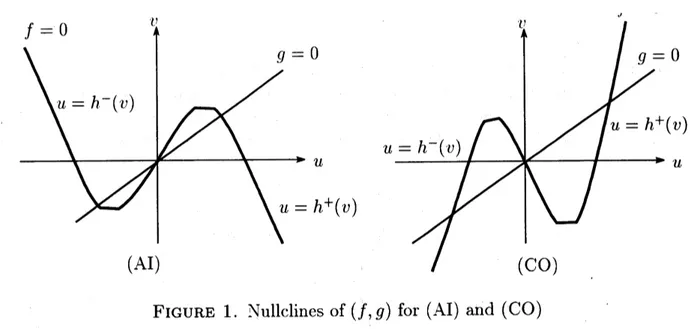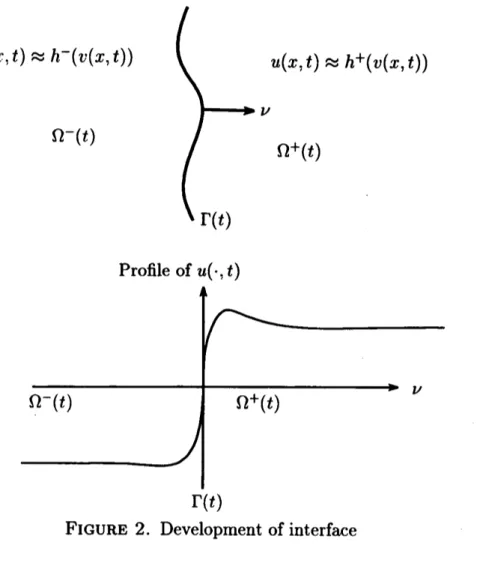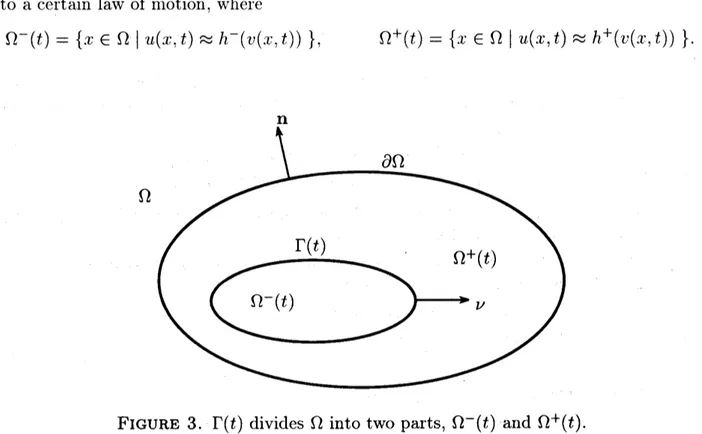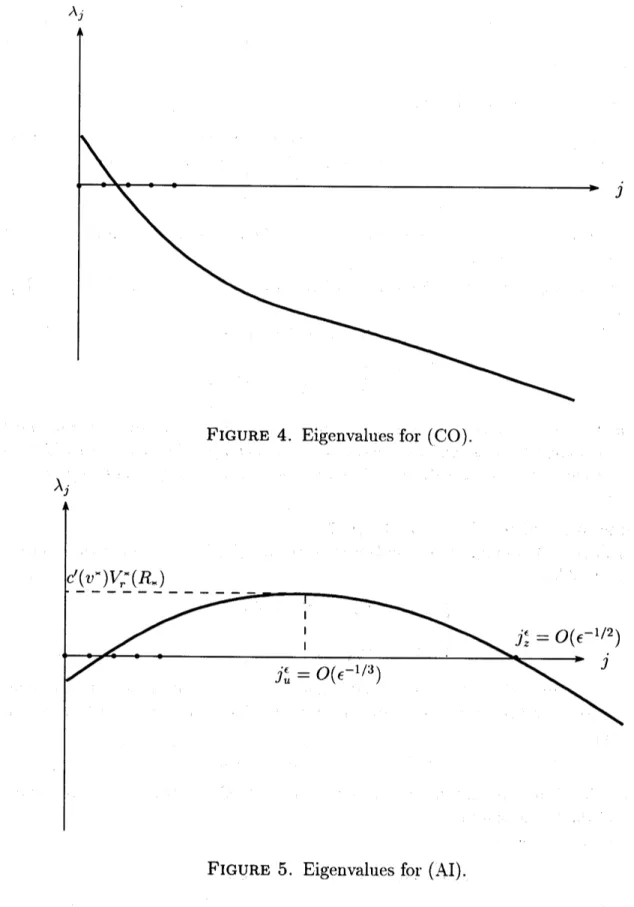Bifurcation of Transition Layers
in Reaction-Diffusion Systems
1広島大学理学研究科 坂元 国望 (Kunimochi SAKAMOTO)
Graduate School ofScience Hiroshima University
Another title of this article may be:
Searching forStable Multi-Dimensional Patterns
in Reaction-Diffusion Systems.
This is astory of my research activities during the last few years, in searching for
multi-dimensional patterns for reaction-diffusion systems. As regard to stable
pat-terns, this is not a successstory. It tellsus, however, about the intricaciesonefaces in
dealing with multi-dimensionaltransition layers. In retrospect, onespace-dimension
was a fortunate exception in which there is no extra dimension for instability to set
in. As soon as the dimension of the domain becomes higher than one, instabilities
creep in to transition layers from the extra dimension along interfaces.
1. REACTION-DIFFUSION EQUATION AND INTERFACE EQUATION
1.1.
Reaction Diffusion
System. Atwocomponent system of reaction-diffusionequa-tions, such as
(R-D) $\{$
$\frac{\partial u}{\partial t}=$ $d_{1}\triangle u+f(u, v)$
$(x\in\Omega, t>0)$
$\frac{\partial v}{\partial t}=$ $d_{2}\triangle v+g(u, v)$
$\frac{\partial u}{\partial \mathrm{n}}=0=\frac{\partial v}{\partial \mathrm{n}}$ $(x\in\partial\Omega, t>0)$
has been widely employed to model various pattern formation phenomena $[4, 7]$. The
domain $\Omega\subset \mathbb{R}^{N}$ here is assumed to be bounded and smooth, and
$\mathrm{n}$ stands for outward
unit normal
on
$\partial\Omega$.According to various types of nonlinearity $(f, g)$, the system above, dispite of its
sim-plicity, is capable of modelling multitude ofpatternformation phenomena. In this article,
we deal with two types of nonlinearity. Prototypical examples ofthese are:
(AI) $f(u.v)=u-u^{3}-v$, $g(u., v)=u$ –v
and
(CO) $f(u., v)=u-u^{3}+v$, $g(u, v)=u$ -v.
12000.
Mathematical$\mathrm{c}\mathrm{l}\mathrm{a}\mathrm{s}\mathrm{s}\mathrm{i}\mathrm{f}\mathrm{i}\mathrm{c}\mathrm{a}\mathrm{t}\mathrm{i}\mathrm{o}\mathrm{n}\mathrm{s}:35\mathrm{B}25$.
$35\mathrm{B}35,35\mathrm{K}57$Keywords: reaction-diffusion system, bifurcation, internal layer, interface equation, free boundar
数理解析研究所講究録 1249 巻 2002 年 90-102
(AI)
FIGURE 1. Nullclines of $(f, g)$ for (AI) and (CO)
When does the system (R-D) produce patterns? Here, a pattern means a spatially
inhomogeneous solution. The following theorem gives us an insight in answering this
question.
Theorem 1 (Conway-Hoff-Srrrdller [3]).There exits a positive constant $d_{0}=d_{0}(\Omega, f, g)$
such that
if
$\min\{d_{1}., d_{2}\}>d_{0}$ then the solutionsof
(R-D) behaves approximately similarto those
of
the ordinarydifferential
equations(ODE) $u_{t}=f(u.v)$, $v_{t}=g(u, v)$,
after
initial transients.The theoremsaysthat the diffusion forces the spatial homogenization of the solution of
(R-D). In this sense, the diffusion acts in accordance with our intuition, and when both
diffusion coefficients $d_{1}$ and $d_{2}$ are rather $1\mathrm{a}\mathrm{r}\mathrm{g}\mathrm{e}_{\dot{\mathit{1}}}$ the system (R-D) does not create any
pattern. This in turn suggests that one ofthe diffusion rates must be small in order for
(R-D) to produce patterns.
Therefore, we assume in the sequel that the diffusion rate $d_{1}$ of $u$ is small while $d_{2}$
remains of order $O(1)$ as $d_{1}arrow 0$:
$0<d_{1}=\epsilon^{2}\ll 1’$. $0<d_{2}=D=O(1)$ (as $\epsilonarrow 0$).
Then (R-D) is rewritten as
(1.1) $\{\begin{array}{l}u_{t}=\epsilon^{2}\triangle u+f(u,v)v_{t}=D\triangle v+g(u,v)\end{array}$ $x\in\Omega t>0$.
In (1.1) (and also in the sequel), the reference to the boundary conditions is omitted,
be-cause
we always deal with the homogeneous Neumann boundaryconditions. The
generalbehavior of solutions to (R-D) with appropriate
initial conditions
$(u(x.0).v(x.0))=(u_{0}(x).v\mathrm{o}(.?\cdot))$
is
well known
[1]. For example,if the second
component $v_{0}(x)$of the initial condition
satisfies $|v_{0}(x)|\leq 2/(3\sqrt{3})$ for $x\in\overline{\Omega}$
, then the solution $(u(x, t),$$v(x, t))$ of(R-D) develops
internal layers
as
$tarrow\propto$.Namely, for large $t$, $u(x.t)\approx h^{-}(v(x., t))$ for $x\in\Omega^{-}(t)$ and $u(x,t)\approx f^{+}(v(x_{\dot{J}}t))$ for
$x\in\Omega^{+}(t)$, thus
creating
asharp transition of $u(x,t)$ from the leftbranch
$u=h^{-}(v)$ tothe right
branch
$u=h^{+}(v)$ of thenullclien
$\{f=0\}$ (cf. Figure 1)near
the set $\Gamma(t)$, calledinterface. The development of the sharp transition layer is caused by the bistability of
$u(x.t)’\approx h^{-}(v(x,t))\Omega^{-}(t)$
$\}_{\Gamma(t)}\nu_{\Omega^{+}’(t)}u(x.t)\approx h^{+}(v(x,t))$
FIGURE
2. Development of interfacethe scalarordinary differential equation
$\frac{du}{dt}=f(u_{2}v)$
which is the first equation in (R-D) with the diffusion term being neglected. Note that
$u=h^{-}(\iota,,).\prime h^{+}(v)$ are stable equilibria of the scalar ordinary differential equation for
$|v|<2/(3\sqrt{3})$.
1.2. Interface Equation. When thetransition layerbecomes sosharpthat the diffusion
term $\epsilon\triangle u$ cannot be neglected, the location of the layer
$\Gamma(t)\subset\Omega$
.
called theinterface
at$t>0$ which
divides
$\Omega$ into two regions $\Omega^{\pm}(t)$ (cf. Figure 3), startsmigrating
accordin$\mathrm{g}$
92
to acertain law of motion where
$\Omega^{-}(t)--\{x\in\Omega|u(x, t)\approx h^{-}(v(x., t))\}$. $\Omega^{+}(t)=\{x\in\Omega|u(x, t)\approx h^{+}(v(x, t))\}$.
$\Omega$
FIGURE 3. $\Gamma(t)$ divides $\Omega$ into two parts, $\Omega^{-}(t)$ and $\Omega^{+}(t)$.
In order to describe the motion law., let us consider the following nonlinear eigenvalue
problem:
$\phi’(z)+c\phi’(z)+f(\phi(z), v)=0$ $(z\in \mathbb{R})$,
$\lim_{zarrow-\infty}\phi(z)=h^{-}(v).$, $\lim_{zarrow+\infty}\phi(z)=h^{+}(v)$, $\phi(0)=0$.
It is known that the problem has aunique solution pair $(\phi(z), c(v))$ for $v\in(\underline{v}_{\dot{l}}\overline{v})$. The
wave speedsatisfies:
(WS) $\{$
$d(u)>0$ for (AI)
$c’(v)<0$ for (CO)
It turns out that the sign of $c_{J}’(v)$ plays acrucial role in the following discussions.
When the $u$-component develops internal layer it is either $u(x.t)\approx h^{-}(v(x., t))$
or
$u(x, t)\approx h^{+}(v(x., t))$, on $\Omega^{-}(t)$ or $\Omega^{+}(t)$. respectively. So it is natural to define $g^{*}$ by
$g^{\mathrm{x}}(v, xj\Gamma(t))=\{$
$g(h^{-}(v), v)$ if $x\in\Omega^{-}(t)$
$g(h^{+}(v)., v)$ if $x\in\Omega^{+}(t)$.
Themotion-law of the interface under the time scale of (1.1) isdescribed bythe following
system of equations:
(1.2-a) $\mathrm{v}(Xj\Gamma(t))=0$ $(x \in\Gamma(t), t>0)$,
(1.2-b) $v_{t}=D\triangle v+g^{\mathrm{x}}(v.xj\Gamma(t))$ $(x\in\Omega\backslash \Gamma(t)., t>0).$,
(1.2-c) $v(\cdot.t)\in C^{1}(\overline{\Omega})\cap C^{2}(\Omega\backslash \Gamma(t))$ .
In (1.2-a), $\mathrm{v}(Xj\Gamma(t))$ is the speed of $\Gamma(t)$ at $x\in\Gamma(t)$ along the unit normal vector $\nu(x.t)$
pointing into $\Omega^{+}(t)$. The condidion (1.2-c) is called a $C^{1}$-matching condition, which is of
crucial importance.
The interface equation (1.2-a) above says that $\Gamma(t)$ does not
move
under the time scaleof (1.1), $\Gamma(t)\equiv\Gamma(0)$. Therefore, (1.2-b) is a gradient system and its solutions approach
equilibrium solutions, i.e., solutions of
(1.2-Equil.) $\{$
$0=D\triangle v+g^{\mathrm{x}}(v, x;\Gamma(0))$ $(x\in\Omega\backslash \Gamma(0))$
$v(\cdot)\in C^{1}(\overline{\Omega})\cap C^{2}(\Omega\backslash \Gamma(0))$
.
Does (2.1-Equil.) have
a
solution fora
reasonable initialinterface
$\Gamma(0)$?The
answer
isyes.
1Ve do
not, however,dwell
on
thisissue here.
The reason why the interface does not move in (1.2) is because the time scale of (1.1)
is too slow. Let
us
rescale time by $tarrow t/\epsilon$ to obtain:(1.3) $\{\begin{array}{l}\epsilon u_{t}=\epsilon^{2}\triangle u+f(u,v)x\in\Omega t>0\epsilon v_{t}=D\triangle v+g(u.v)\prime\end{array}$
The interface equation for (1.3) is given by
(1.4-a) $\mathrm{v}(Xj\Gamma(t))=c(v(x, t))$ $(x\in\Gamma(t), t>0)$,
(1.4-b) $0=D\triangle v+g^{\mathrm{x}}(U.Xj\Gamma(t))$ $(x\in\Omega\backslash \Gamma(t)., t>0).$,
(1.4-c) $v(\cdot\dot{\prime}t)\in C^{1}(\overline{\Omega})\cap C^{2}(\Omega\backslash \Gamma(t))$.
Note that the left hand side of (1.4-b) is equal to 0, but not to $v_{t}$. This
can
beunder-standable if
we
recall that the limit $\epsilonarrow 0$ in (1.3) can have an effect of the limit $tarrow \mathrm{o}\mathrm{c}$in (1.2) because ofthe rescaling of time.
Theorem 2(Nishiura [8] for $N=1$. Chen [1] for $N\geq 2$)
(1) Let $(v_{0}(x), \Gamma(0))$ be a smooth initial condition
for
(1.4). There eist $T>0$ and$a$
unique solution $(v(x,t)\dot,$$\Gamma(t))$
of
(1.4) on $[0, T]$.(2) There exist afamily
of
solutions$(u^{\mathrm{e}}(x.t), v^{\epsilon}(x, t))$of
(1.3)for
sufficiently small$\epsilon>0$sttch that
$\epsilon\varliminf_{0}v^{\epsilon}(x,t)=v(x.t)$ uniformly
on
$\overline{\Omega}\cross[0,T]$ $\epsilon\varliminf_{0}^{u^{\epsilon}(x_{l}t)=}.\{$$h^{-}(v(x_{\dot{l}}t))$ unifomly
on
$\bigcup_{t\in[0,T]}\Omega^{-}(t)\backslash \Gamma_{\delta}(t)\cross\{t\}$$h^{+}(v(x, t))$ uniformly
on
$\bigcup_{t\in[0,T]}\Omega^{+}(t)\backslash \Gamma_{\delta}(t)\cross\{t\}$for
each $\delta$ $>0$, where$\Gamma_{\delta}(t):=$
{
$x\in\Omega|$ dist(x,$\Gamma(t))<\delta$}
is the $\delta$-neighborhood
of
$\Gamma(t)$.The last theorem saysthat the interface equation (1.4) does approximate the
reaction-diffusion system (1.3) on finite time intervals. Even if the solution $(v(x., t),$$\Gamma(t))$ of (1.4)
exists
on
$[0\dot, \propto)$. the approximation in thesense
ofTheorem 2(2) above is valid onlyon
afinite time
interval $[0, T_{e}]$ (although $T_{\epsilon}arrow\infty$as
$\epsilonarrow 0$ may bethe
case).Therefor
$\mathrm{e}$94
some of asymptotic information on the solutions of (1.3) may not be captured by only
analyzing the behavior of solutions of (1.4).
2. FREE INTERFACE PROBLEM AND EQUILIBRIUM TRANSITION LAYERS
Afirst step to analyze asymptotic (as $tarrow\propto$) behaviors of solutions to(1.3) is to
deal with equilibrium solutions, namely, solutions of the semilinear singularly perturbed
elliptic system:
(2.1) $\{$
0 $=$ $\epsilon^{2}\triangle u+f(u, v)\dot{\prime}$
$x\in\Omega$
0 $=$ $D\triangle v+g(u, v)’$
.
$0=\partial u/\partial \mathrm{n}=\partial v/\partial \mathrm{n}x\in\partial\Omega$.
As mentioned earlier., the result in Theorem 2guarantees the approximation of (1.3) by
(1.4) only on finite time intervals, and hence do not answer the following question:
If
(1.4) has an equilibrium solution $(\Gamma_{0}, v(x;\Gamma_{0}))$, then, does (2.1) have acor-responding equilibrium solutions
for
small $\epsilon>0$?The answer to the question is affirmative when the space dimension $N=1$. $\mathrm{M}\mathrm{i}\mathrm{m}\mathrm{u}\mathrm{r}\mathrm{a}_{!}$.
Tabataand Hosono [6] proved the existence of equilibrium transition layers, and Nishiura
and Fujii [9] established their stability property. According to Nishiura and Fujii [9],
the equilibrium transition layers are stable for $(\mathrm{A}1)$-nonlinearity and ustable for $(\mathrm{C}\mathrm{O})-$
nonlinearity
An answer to the question above for ahigher dimensional case $(N\geq 2)$ is given in [10]
in ageneral situation, which we now describe by using interface equation.
The equilibrium solution of(1.4) gives rise to the following
free interface
problem:(2.2-a) $0=D\triangle V^{*}+g^{*}(V^{*}.x;\Gamma_{0})$ $(x\in\Omega\backslash \Gamma_{0}).$
,
(2.2-b) $\mathrm{L}^{\Gamma^{\mathrm{x}}}(x)=0$
on
$\Gamma\circ$ and $\partial 1^{\gamma*}(x)/\partial \mathrm{n}=0$on
ac
(2.2-c) $V^{*}(\cdot)\in C^{1}(\overline{\Omega})\cap C^{2}(\Omega\backslash \Gamma_{0})$ ,
where the unknown is a pair $(V^{*}(x).\Gamma_{0})$. Note that the nonlinearity $g^{*}(v, x;\Gamma_{0})$ has a
jump discontinuity along $\Gamma_{0}$. The problem (2.2) is called
afree interface
problembecausethe $\mathrm{e}\mathrm{q}\mathrm{u}\mathrm{i}1\mathrm{i}\mathrm{b}\mathrm{r}\mathrm{i}_{11}\mathrm{m}$interface $\Gamma\circ$ is unknown. The $C^{1}$-matching condition (2.2-c) forces that
the problem cannot have asolution for an arbitrarily given interface $\Gamma_{0}$.
Remark 1. Note that the
free interface
problem (2.2-a, $\mathrm{b}.,$ $\mathrm{c}$) isdifferent from
theproblem (1.2-Equil.)in which $\Gamma(0)$ is arbitrarily given. In (2.2-b), the Dirichlet condition
$V^{\mathrm{x}}=0$ is to be
satisfied
on $\Gamma_{0_{i}}$ while in (1.2-Equil.)no such condition is imposed.To the best of
our
knowledge, the existence of solutions of the free interface problem(2.2) is not known in ageneral situation. We hereafter
assume
that (2.2) has asmoothsolution $(V^{\mathrm{x}}(x)\dot, \Gamma_{0})$. Our question then is: Does this $(V^{\mathrm{x}}(x).\Gamma_{0})$ give rise toa transition
layer solution
of
(2.1)It turns out that (1.4) is not acorrect interface equation for (1.3), at least
as
regardto equilibrium solutions. The correct
one
is given by replacing (1.4-a) by acurvaturedependent version
(1.4-a’) $\mathrm{v}(x;\Gamma(t))=c(v(x, t))-\epsilon\kappa(x;\Gamma(t))$ $(x\in\Gamma(t)., t>0).$,
where $\kappa(x;\Gamma)$ stands for the
sum
of principal curvatures of $\Gamma$ at $x\in\Gamma$. Letus
linearize(1.4-a.,b.,c) at the solution $(V^{\mathrm{x}}(x), \Gamma_{0})$ of(2.2). Let $v^{\mathrm{x}}$ be such that $v(v^{\mathrm{x}})=0$. Then, the
associated linearized eigenvalue problemis given by
(2.3-a) $\lambda p=\epsilon(\triangle^{\Gamma_{0}}+\sum_{j=1}^{N-1}\kappa_{\mathrm{j}}(x)^{2})p+c’(v^{\mathrm{x}})\frac{\partial V(x)}{\partial\nu(x)}.|_{\Gamma_{0}}p+c’(v^{\mathrm{r}})q|_{\Gamma_{0}}$ $x\in\Gamma_{0}$, (2.3-b) $0=D\triangle q+g_{v}.(V^{\mathrm{x}}(x),x;\Gamma_{0})q-[g^{\mathrm{K}}]p\otimes\delta_{\Gamma_{0}}$ $x\in\Omega$
for $p(x)$ (defined for $x\in\Gamma_{0}$) and $q(x)$ (defined for $x\in\Omega$), where $\triangle^{\Gamma_{0}}$
is the
Laplace-Beltrami operator
on
$\Gamma_{0}\dot,$ $\kappa j(x)(j=1_{\dot{J}}\ldots, N-1)$are
principal curvatures at $x\in\Gamma_{0}$ and$[g^{\mathrm{x}}]$ is the jump of $g^{\mathrm{x}}$ across $\Gamma_{0}$:
$[g^{\mathrm{x}}]=g(h^{+}(v^{\mathrm{x}}), v^{\mathrm{x}})-g(h^{-}(v^{\mathrm{x}})., v^{*})$ ($v^{\mathrm{x}}=0$ in
our
examples (AI) and (CO)).In the second equationabove,thesymbol$\delta_{\Gamma_{0}}$standsfor the Dirac-delta functionsupported
on
$\Gamma\Downarrow.$, and hence the equation should be interpreted
in distributional
sense.
Therefore,by writing it in weak form:
$0=-D \int_{\Omega}\nabla q(x)\cdot\nabla\eta(x)dx+\int_{\Omega}g_{v}^{*}(V^{\mathrm{r}}(x)’.x;\Gamma_{0})q(x)\eta(x)dx$
$-[g^{\mathrm{x}}] \int_{\Gamma_{0}}p(x)\eta(x)dS_{x}^{\Gamma_{0}}$
(with $\eta$ being atest function and $dS_{x}^{\Gamma_{0}}$ standing for the volume element on $\Gamma_{0}$), and
integrating by parts, one can recast (2.3-b) as concisely as
(2.3-b’) $\Pi_{0}q|_{\Gamma_{0}}+\frac{[g]}{D}.p=0$ $x\in\Gamma_{0}$.
The operator $\Pi_{0}$ in the last equation
is
the $\mathrm{D}\mathrm{i}\mathrm{r}\mathrm{i}\mathrm{c}\mathrm{h}1\mathrm{e}\mathrm{t}- \mathrm{t}_{0_{\wedge}^{-}}\mathrm{V}\mathrm{e}\mathrm{u}\mathrm{m}\mathrm{a}\mathrm{n}\mathrm{n}$map defined
by$\Pi_{0}q(x):=\frac{\partial v_{0}^{-}(x)}{\partial\nu}-\frac{\partial v_{0}^{+}(\tau)}{\partial\nu}$.
$(x\in\Gamma_{0})$
in which $v_{0}^{\pm}(x)$ are solutions of the following problem:
$D\triangle\iota’,\pm+g_{1}.,(V^{\mathrm{r}}(x),x;\Gamma_{0})_{l’}^{\pm},=0$ $(x\in\Omega^{\pm})$
.
$v^{\pm}(x)=q(x)$ $(x\in\Gamma_{0})$
.
$\frac{\partial v^{\pm}(x)}{\partial \mathrm{n}}=0$
$(x\in\partial\Omega)$,
where $\Omega^{-}\cup\Omega^{+}=\Omega\backslash \Gamma_{0}$.
Lemma
3([10]). Assume that$g_{t}.,$ $<0$on
$\Omega\backslash \Gamma_{0}$.(1) The operator $\Pi_{0}$ : $C^{2+a}(\Gamma_{0})arrow C^{1+a}(\Gamma_{0})$ is inveriible
for
$0<\alpha<1$.
and extends toa
self-adjoint operatoron
$L^{2}(\Gamma_{0})$.(2) Eigenvalues
of
$\Pi_{0}$ are all positive:$0<\pi_{0}<\pi_{1}<\ldots<\pi_{j}arrow\propto$ $(jarrow\propto)$,
where only distinct eigenvalues are listed.
For both of
our
nonlinearities (AI) and (CO), the condition $g_{v}^{*}<0$ is satisfied.There-fore, thanks to Lemma 3, we can solve $(2.3- \mathrm{b}’.)$ in $q|_{\Gamma_{0}}$ and substitute it into (2.3-a) to
reduce the eigenvalue problem (2.3) to
(2.4) $\lambda p=A^{\epsilon}p$
on
$\Gamma_{0}$,where $A^{\epsilon}$ is defined by
(L) $A^{\epsilon}p:= \epsilon(\triangle^{\Gamma_{0}}+\sum_{j=1}^{N-1}\kappa_{j}(x)^{2})p+c’(v^{*})\frac{\partial V^{*}(x)}{\partial\nu(x)}|_{\Gamma_{0}}p-c’(v^{*})\frac{[g^{*}]}{D}\Pi_{0}^{-1}p$ on $\Gamma_{0}$.
Theorem 4 ([10]).
(1) Let $(V^{*}, \Gamma_{0})$ be a smooth solution
of
(2.2). Suppose that the operator$A^{\epsilon}$
:
$C^{2+\alpha}(\Gamma_{0})arrow C^{\alpha}(\Gamma_{0})$ $(0<\alpha<1)$is
invertible
uniformly in$\epsilon\in(0, \epsilon\circ]$for
some
$\epsilon\circ\cdot$ When (2.1) has a familyof
solutions
$(u^{\epsilon}., v^{\epsilon})$ such that
$\varliminf_{\epsilon 0}v^{\epsilon}(x)=V^{*}(x)$ uniformly in
$\overline{\Omega}$
$\lim_{\epsilonarrow 0}u^{\epsilon}(x)=\{$
$h^{-}(V^{*}(x))$ uniformly on $\Omega_{\delta}^{-}$
$h^{+}(V^{*}(x))$ uniformly on $\Omega_{\delta}^{+}$
for
each $\delta>0$, where $\Omega_{\delta}^{\pm}$ aredefined
by$\Omega_{\delta}^{\pm}=$
{
$x\in\Omega^{\pm}|$ dist($x.$,$\Gamma_{0})\geq\delta$}.
(2) When $c’(v)<0$, the operator$A^{\epsilon}$ above is inveriible uniformly in $\epsilon>0$ small.
(3) The solutions in (1)
are
unstable.Outline ofProof. The proofof Theorem 4 (1) consists of two steps.
Step 1is due to Ikeda [5]. It was shown in [5] that there exist two families ofboundary
layer solutions $(u^{\epsilon,\pm}, v^{\epsilon,\pm})$ on $\Omega^{\pm}$
with transition layers along the
common
interface $\Gamma_{0}$.In Step 2., we match the two families ofsolutions as follows.
(2.5) $(u^{\epsilon,-},v^{\epsilon,-})=(u^{\epsilon,-},v^{\epsilon,+})$ $( \frac{\partial u^{\epsilon,-}}{\partial\nu},\frac{\partial v^{\epsilon,-}}{\partial\nu})=(\frac{\partial u^{\epsilon,+}}{\partial\nu}’.\frac{\partial v^{\epsilon,+}}{\partial\nu})$ on $\mathrm{r}_{0}$.
It turns out that the matching conditions
are
equivalent to(2.6) $A^{\epsilon}p=\mathrm{a}$ known function $\in C^{\alpha}(\Gamma_{0})$ $(0<a<1)$ .
The condition
on
the invertibility of$A^{\epsilon}$ enablesus
to solve $(2.6)\dot,$ which in turn allowsus
to establish the matching conditions (2.5), completing the proof of (1).
The idea of proof for (2) and (3) will be explained below when we prove Theorems 6
In $(\backslash 1^{\tau}\mathrm{S})$ in
\S 1.2,
we have shown that $c’(\iota’)<0$ for the nonlinearity (CO). Therefore,Theorem 4applies to this case and the existence of a family of transition layer solutions
of(2.1) is established.
What is going
on
when the nonlinearity is of $(\mathrm{A}\mathrm{I})- \mathrm{t}\mathrm{y}\mathrm{p}\mathrm{e}^{?}$.
when $c^{l}(v)>0$,one can
show that the eigenvalue problem (2.4) has small eigenvalues. More pricisely, there exists
asequence $\{\epsilon j\}$ with $\epsilon_{1}>\epsilon_{2}>\ldots>\epsilon jarrow \mathrm{O}$
as
$iarrow \mathrm{o}\mathrm{o}$ such that for each$\epsilon=\epsilon_{j}\dot,$
$0$ is an eigenvalue of the problem (2.4). This suggests that
an
infinite series of staticbifurcations of transition layer solutions may be taking place at each $\epsilon=\epsilon j$
.
Toprove
thelast statement
in
ageneralsituation is
notso easy. So let us deal with
aspecialcase
in
the next
Section.
3. BIFURCATION OF TRANSITION $\iota \mathrm{A}\mathrm{Y}\mathrm{E}\mathrm{R}\mathrm{S}$
$\mathrm{Y}\mathrm{V}\mathrm{e}$ treat in this section the
case
where the domain $\Omega$ is the unit disk in $\mathbb{R}^{N}$:$\Omega=\{x\in \mathbb{R}^{r\mathrm{V}}||x|<1\}$.
Theorem 5([11]).
(1) There eists $D_{0}>0$ such that the
ffee interface
problem (2.2) has a radiallysym-metric solution $(V^{*}(|x|)., \Gamma_{0})$ with $\frac{d}{dr}V^{\mathrm{x}}(r)>0$
for
each $D\in[D_{0}., \infty)$, where$\Gamma_{0}=\{x\in \mathbb{R}^{N}||x|=R_{\wedge}\}$ $(0<R. <1)$.
(2) For both nonlinearities (AI) and (CO), (2.1) has a family
of
radially symmetricsolutions $(u^{\epsilon}(|x|), v^{\epsilon}(|x|))$ with the same limiting behavors as in Theorem
4for
each$D\in[D_{0_{\dot{\prime}}}\infty)$.
For aradially symmetric pair $(V^{\mathrm{x}}(r).\Gamma_{0}).$
, the free interfaceproblem (2.2-a, $\mathrm{b}$, c)reduces
to aproblem described by an ordinary differential equation (ode). Based upon adetailed
analysis of the (ode), the proofofTheorem 5(1) is rather elementary.
The proof of Theorem 5(2) goes as follows. In the same
manner
as in the proof ofTheorem 4, the existence is equivalent to
$A_{0}^{\epsilon}p=\mathrm{a}$
known
constant,where $A_{0}^{\epsilon}$ is aconstant given by
$A_{0}^{\epsilon}=c’(0)[V_{r}^{\cdot}(R_{\mathrm{x}})- \frac{1}{D}\pi_{0}^{-1}]+O(\epsilon)\neq 0$
in which $\gamma_{10}$ is the first eigenvalue of the
Dirichlet-t0-Neumann
map $\Pi_{0}$.Theorem 6([11]). The equilibrium solutions $(u^{\epsilon}(|x|), v^{\epsilon}(|x|))$
of
Theorem 5are unstablewith respect to (1.3). Moreover, there are (cf. Figures
4and
5)$\bullet$ two unstable eigenvalues $\lambda_{0}>\lambda_{1}>0$
for
$(CO)’ nonlinearity$; $\bullet$ many unstable eigenvaluesfor
(AI)-nonlinearity,$\lambda_{0}<\lambda_{1}<0<\lambda_{2},\cdots$
.
$\dot{\prime}\lambda_{j_{C}}$,where $j_{\epsilon}=O(\epsilon^{-1/2})$.
$\lambda_{j}$
$j$
FIGURE 4. Eigenvalues for (CO).
FIGURE 5.
Eigenvalues for (AI). In the $above_{i}$ the multiplicity $m_{j}$of
the eigenvalue $\lambda_{j}$ is given by$,n_{j}= \frac{(2j+\grave{\wedge}-\prime 2\prime)(j+\sim^{l}\backslash ^{r}-3)!}{j!(\wedge\prime\backslash -2)!}$
.
which is the dimension
of
the spaceof
spherical har monicsof
degree$\ovalbox{\tt\small REJECT}$. Moreover,eigen-function
associatedwith$\mathrm{A}_{\ovalbox{\tt\small REJECT}}$ areof
theform
$p(|\mathrm{r}|)\mathrm{O}(y)with|y|\ovalbox{\tt\small REJECT}$ ) and0
beinga
sphericalharmonics
of
degree$\ovalbox{\tt\small REJECT}\ovalbox{\tt\small REJECT}$.We
now
state abifurcation result.Theorem 7([11]). Assume that
$N=2$and the
nonlinearity in (2.1)is
of
(AI)-type.There eists a sequence $\{\epsilon_{j}\}$
for
sufficiently large $j$, say$j\geq O(\epsilon_{0}^{-1/2})$, with$\epsilon_{j-1}>\epsilon_{j}arrow 0$ (as $jarrow\infty$)
such that when $\epsilon$ passes
$\epsilon_{j}$,
a non-radial
solution$(u^{\epsilon,j}, v^{\epsilon,j})$
of
(2.1)bifurcates from
thetrivial branch $(u^{\epsilon_{!}}.v^{\epsilon})$. Moreover,
(1) the symmetry group
of
thebifurcated
solution $(u^{\epsilon,j}., v^{\epsilon,j})$ is the dihedral group $\mathrm{D}_{j}$of
order$2j$
:
(2) the
bifurcation
points $\epsilon_{j}$are
explicitly characterized as:$\epsilon_{j}=c’(v^{\mathrm{x}})\frac{W}{dr}.(R_{\mathrm{x}})\frac{1}{j^{2}}+O(\frac{1}{j^{4}})$ (as $jarrow\propto$).
Remark 2. The restriction $N=2$ in Theorem 7is only
for
the sakeof
avoiding thealgebraic complication in identifying subgroups
of
the orthogonal group $O(N)$ which have$a$ one-dimension$al$
fied
point subspace.Similar
results holdfor
$N\geq 3$ withmore
intricatestatements.
Outline of proof of Theorems 6and 7.
We linearize (1.3) around the trivial branch$(u^{\epsilon}(|x|)\dot, v^{\epsilon}(|x|))$ and consider the associated
eigenvalue problem:
(3.1) $\{\begin{array}{l}\epsilon\lambda\phi=\epsilon^{2}\Delta\phi+f_{u}^{\epsilon}\phi+f_{v}^{\epsilon}\psi\epsilon\lambda\psi=D\Delta\psi+g_{v}^{\epsilon}\psi+g_{u}^{\epsilon}\phi_{\dot{r}}\end{array}$
where $f_{u}^{\epsilon}$ etc. are
evaluated
at the trivial branch. The eigenvalues of (3.1)are
dividedinto two classes, critical and
non-critical
eigenvalues. An eigenvalue $\lambda^{\epsilon}$ of (3.1) is callednon-critical if
${\rm Re}\lambda^{\epsilon}arrow-\propto$ (as $\epsilonarrow 0$).
From this definition,
we
only need to examine the critical eigenvalues to determine thestability ofthe trivial solutions $(u^{\epsilon}., v^{\epsilon})$.
The key is the following:
{critical
eigenvalues
of (3.1)} $\approx\sigma(A$‘).Namely, the critical eigenvalues
are
well approximated by the eigenvalues of the operator$A^{\epsilon}$. In
our
radially symmetric case, the eigenvalues of$A^{\epsilon}$ are explicitly given by(3.2) $\lambda_{j}=c’(\iota^{\mathrm{x}}’.)[\frac{d\mathrm{L}^{r}/}{dr}.(R_{\mathrm{x}})-\frac{1}{D}\frac{[g]}{\gamma_{1j}}.]-\frac{\epsilon}{R^{2}}.(j-1)(j-1+-\nwarrow^{\vee})$ $(j=1.2.. )’\ldots$
$\frac{-1}{R_{\mathrm{x}}^{2}}(j-1)(j-1+N)$
is the $j$-th eigenvalue of the Jacobi operator
$\triangle^{\Gamma_{0}}+\sum_{k=1}^{\mathit{1}\backslash ^{r}-1}\kappa(x)^{2}$
on
$\Gamma_{0}=\{x\in \mathbb{R}^{N}||x|=R_{\star}\}$.Let
us
recall here that $\pi_{j}$ is the$j$-th eigenvalue of the Dirichlet-t0-Neumann map$\Pi_{0}$, and
it is asymptotically
characterized
([10])as
(3.3) $\lim_{jarrow\infty}\frac{\pi_{j}}{\sqrt{j(j+l\mathrm{V}-2)}}=\frac{2}{R_{*}}$.
Moreover thanks to the maximum principle ([10]), one
can
prove that(3.4) $\frac{dV^{*}}{dr}(R_{*})-\frac{1}{D}\frac{[g^{*}]}{-\pi_{j}}\{$
.
$<0$ if $j=1,2$ $>0$ if $j\geq 3$.
From (3.2), (3.3) and (3.4), the statements in Theorem 6follows immediately.
The proof of Theorem 7is furnished by the equivariant branching lemma due to
Van-derbauwhede [12] and Cicogna [2], The characterization of the critical eigenvalues as in
(3.2)-(3.4) plays adecisive role in verifying the conditions of the branching lemma.
Acknowldgement: Over the last decase and ahalf, Ihave benefitted from so many
people, some directly and others indirectly through research papers,
on
the contents ofthis article. Ilist names of these people to acknowledge their contributions. They are, in
alphabetical order: N. Alikakos, P. Bates, $\mathrm{X}$-F. Chen, $\mathrm{X}$-Y. Chen, M. del Pino, S.-I. Ei,
P. Fife, H. Fujii, G. Fusco, J. Hale, Y. Hosonl,$0.$, H. Ikeda, M. Ito, $\mathrm{C}’$. Jones, X.-B. $\mathrm{L}i\mathrm{n}$, J.
Mallet-Paret, M. Mimura, N. Nefedov, Y. Nishiura, H. Suzuki, M. Tabata, I. Takagi, M.
Taniguchi, E. Yanagida, and many others.
REFERENCES
[1] X. Chen, Generation and propagation of interfacesin
reaction-diffusion
systems,Trans. Amer. Math. Soc, 334(1992), 877-913. $|$[2] G.Cicogna, Symmetry Breakdownfrom Bifurcation. Lettere al Nuovo Cimento 31 (1981), 600-602.
[3] E. Conway, D. Hoff and J. Smoller, Large time behavior ofsolutions ofsystems ofnonlinear
reaction-diffusion equations, SIAM J. Appl. Math. 35(1976), 1-16.
[4] P.C. Fife, Propagator-controller systems and chemicalpatterns, in: Non-Equilibrium Dynamics in Chemical Systems, eds. C. Vidal and A. Pacault (Springer-Verlag, Berlin 1984)$\dot{\prime}76- 88$.
[5] H. Ikeda. On the $asym,pto\dagger,ic$ solutions for a weakly coupled elliptic boundary value problem with $a$
small parameter, HiroshimaMath. J. 16(1986), 227-250.
[6] M. Mimura. M. Tabata and Y. Hosono, Multiple solutions oftwO-point boundary value problems of
Neumunn type wr,th, a sm,allparameter, SIAM J. Math. Anal., 11(1980), 613-631.
[7] J.D. Murray, Mathematical Biology; Biomathematics Texts Vol. 19, Springer-Verlag Berlin
Heidel-berg (1989).
[8] Y. Nishiura, Coexistence
of
infintely many stable solutions to reactiondiffusion
systems in the sin-gular $\lim,it$. Dynamics Reported. $3(1994)$.
25-103[9] Y. Nishiura and H. Fujii. Stability ofsingularly perturbed solutions to systems ofreaction-diffusion
equations. SIAM J. Math. Anal. 18(1987), 1726-1770.
[10] K. Sakamoto, Internal layers in high-dimensional domains. Proc. Royal Soc. of Edinburgh
$128\mathrm{A}(1998)$, 359-401.
[11] K. Sakamoto, Infinitely manyfinemodesbifurcating
from
radiallysymmetricinternal layers. Preprint (2000).[12] A. Vanderbauwhede, Local Bifurcationand Symmetry. ${\rm Res}$. Notes Math. 75. Pitman, Boston,1982



